Bioaccumulation of Heavy metal toxicity in the vegetables of Mahalgaon, Nagpur, Maharashtra (India)
A.S Mahakalkar1 * , R.R. Gupta2 and S.S. Nandeshwar1
1
Sevadal Mahila Mahavidyalaya,
Sakkaradara Square,
Nagpur - 09,
India
2
Mohota Science College,
Sakkaradara Square,
Nagpur - 09,
India
DOI: http://dx.doi.org/10.12944/CWE.8.3.16
Copy the following to cite this article:
Mahakalkar A. S, Gupta R. R, Nandeshwar S. N. Bioaccumulation of Heavy metal toxicity in the vegetables of Mahalgaon, Nagpur, Maharashtra (India). Curr World Environ 2013;8(3) DOI:http://dx.doi.org/10.12944/CWE.8.3.16
Copy the following to cite this URL:
Mahakalkar A. S, Gupta R. R, Nandeshwar S. N. Bioaccumulation of Heavy metal toxicity in the vegetables of Mahalgaon, Nagpur, Maharashtra (India). Curr World Environ 2013;8(3). Available from: http://www.cwejournal.org/?p=5281
Download article (pdf)
Citation Manager
Publish History
Select type of program for download
| Endnote EndNote format (Mac & Win) | |
| Reference Manager Ris format (Win only) | |
| Procite Ris format (Win only) | |
| Medlars Format | |
| RefWorks Format RefWorks format (Mac & Win) | |
| BibTex Format BibTex format (Mac & Win) |
Article Publishing History
| Received: | 2013-10-03 |
|---|---|
| Accepted: | 2013-11-17 |
Mahalgaon is a village in Kamptee Taluka, Nagpur district of Maharashtra state, India1 Nag River is the main river which flows through the city and passes through Mahalgaon village hence it is the easiest and cheapest source of water for irrigation to the villagers on the bank of this river. The river serves as the drainage for the city and is highly polluted by urban waste and heavy metals2
Most of the village formers are engaged in vegetable cultivation and the village serves as one of the main supplier of vegetables required in the Nagpur market. All the fields and farms are irrigated by the Nag river water.
Although trace quantities of certain heavy metals such as Chromium, Cobalt, Cupper, Manganese, Zinc etc. are essential micronutrients for higher animals and plant growth but their high concentration may cause health problem3,4 hence lot of work has been carried out to assess heavy metal bioaccumulation in different vegetables and plants5,6,7,8,9,10,11,12 which show that heavy metals are non biodegradable and persistent environmental contaminants which are deposited on the surfaces and then absorbed into the tissues of vegetables. Plants take up heavy metals by absorbing them from contaminated soil.
By consumption of vegetables heavy metals enter the food chain8 and if consumed in high concentration it may lead to the chronic accumulation of heavy metals in the kidney and liver of humans causing disruption of biochemical processes leading to cardiovascular, nervous, kidney and bone disease8,13
The purpose of this study was to study the bioaccumulation of heavy metals i.e. Cu, Mn, Fe, Zn, Ni and Pb in Water, Soil and Vegetables irrigated by Nag River water and to evaluate the level of bioaccumulation of the metals by the different vegetables. These are the most toxic heavy metals in water, soil and vegetables.
Material and Methodology
Analytical reagent (AR) grade chemicals and distilled water were used throughout the study.
The sampling was carried out according to grab method as given in APHA for the sampling of water,14 soil and vegetables. Five farms were selected in the Mahalaon region for study purpose. Each farm was situated near the bank of Nag River.
Water Sampling
Water samples were collected from five sites along Nag River at Mahalgaon. All the sampling sites were adjacent to the farms which were selected for study purpose. Sampling was made in the summer 2013. The containers used for water sampling were plastic bottles which were thoroughly washed with nitric acid followed by double distilled water. 2ml nitric acid was added in 1 liter water sample for the digestion of heavy metals and it was stored at cold temperature till the further analysis.
The concentration of heavy metals (Cu, Mn, Fe, Zn, Ni, Pb) were analyzed using Atomic Absorption Spectrophotometer (AAS SL-243 ELICO).
Soil Sampling
Soil samples were collected from five sites. Each farm was first subdivided into five parts (four cornors and one centre) and then soil was collected from all the five spots and mixed together to get a composite soil sample from one field. Likewise all the five samples were collected. Sampling was carried out by using plastic equipment instead of metal tool to avoid any cross contamination. The samples were collected in a self locking polythene bags and were sealed so as to avoid any kind of loss or leakage. The soil samples were air dried and then disaggregated with mortar and pestle and dried samples were finely powdered to 2mm thick sieve to make the sample homogeneous.
Vegetables
The vegetables selected for heavy metal analysis were Brinjal (Solanum Melongena), Flower, Bathua (Chenopodium Album), Chawli (Vigna Catjang), Spinach (Spinacia Oleraceae). All this are the common vegetables which are repeatedly consumed by peoples of this area. Grab method was used for collecting vegetable samples.
The plant samples were put through a three step washing sequence, which involved agitating and rinsing first in 0.1% teepol for 15 seconds, followed by 0.1% HCl for 15 seconds and lastly three separate washes in deionised water. The clean vegetable samples were air dried, weighed and placed in a dehydrator at 70 â—¦C for 48–72 hours depending on sample size. Dried samples were weighed and mechanically ground using a stainless steel grinder (<1 mm) for digestion. A portion of the dry vegetable powder material was digested in a mixture of HNO3 and perchloric acid (HClO4). The extracts were analyzed for various elements using AAS.
Result and Discussion
The concentrations of the heavy metals (ml/l and mg/g) in water, soil and vegetables are given in tables 1, 2, 3respectively.
 |
Table 1: Concentration (mg/l) of Heavy Metals in water samples. Click here to View table |
In water the concentration of Iron and zinc was highest whereas conc. of Nickel and lead was lowest.
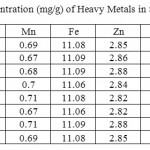 |
Table 2: Concentration (mg/g) of Heavy Metals in Soil samples. Click here to View table |
Table 2 shows that the city farm soil were moderately enriched in Cu, Mn and Ni, but strongly enriched with Fe and Zn may be due to anthropogenic contributions. The concentration of Cu, Mn, Fe, Zn, Ni, Pb in soil varied from 0.40-0.44; 0.67-0.71; 11.06-11.09; 2.82-2.88; 0.09-0.13; 0.081-0.085 mg/g respectively at different sites. Similar results are also reported by Tomar et. al, 2000. The order of accumulation of Metals in both soil and vegetables samples was Fe > Zn > Mn > Cu > Ni > Pb.
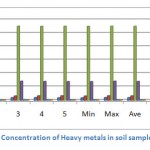 |
Figure 1: Concentration of Heavy metals in soil samples Click here to View figure |
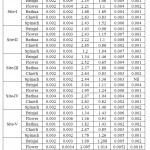 |
Table 3: Concentration (mg/g) of Heavy Metals in Vegetables. Click here to View table |
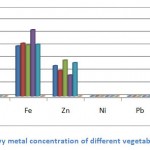 |
Figure 2: Comparison of Heavy metal concentration of different vegetables with the permissible limit Click here to View figure |
Transfer factors for heavy metals from soil to vegetables Table 4 show the Transfer Factor (TF) of Cu, Mn, Fe, Zn, Ni and Pb from soil to plant, which is one of the key components of human exposure to metals through the food chain. Transfer factors were determined to quantify the relative difference in bioavailability of metals to plants or to identify efficiency of plant species to accumulate a given metal. These factors were based on the root uptaken of metals and discount the foliar absorption of atmospheric metal deposits. The degree of accumulation shows that Zn is higher than Fe.
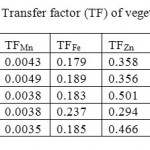 |
Table 4: Soil-plant Transfer factor (TF) of vegetables. Click here to View table |
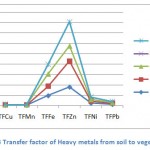 |
Figure 3: Transfer factor of Heavy metals from soil to vegetables Click here to View figure |
The soil-plant transfer factor of different heavy metals shows the following order-
TFZn> TFFe>TFCu>TFNi>TFMn>TFPb.
![vol8no3_maha_bio_t5 Table 5. Permissible limits of heavy metals given by IS/WHO/FAO[15]](http://www.cwejournal.org/wp-content/uploads/2013/11/vol8no3_maha_bio_t5-150x150.jpg) |
Table 5: Permissible limits of heavy metals given by IS/WHO/FAO.15 Click here to View table |
When table 1, 2, 3 were compared with the table 5 to access the concentration of heavy metals with reference to their permissible limits in water, soil, vegetables it was found that Fe and Zn were in very high conc. Presence of these metals in higher concentration than permissible limits given by IS/WHO/FAO[15]. The conc. of Pb and Ni was below detectable limits and conc. of Cu and Mn was slightly above the permissible limits.
Conclusion
The concentration of Fe and Zn in the soil samples were very high compared to the WHO/FAO maximum permissive limits while the concentrations of Cu and Mn were slightly above the permissible limits. The concentration of Pb and Ni were below the detection limits in soil. On the other hand in all the vegetables, the concentration of heavy metals was higher than the WHO/FAO permissible limits.
From the above study it was found that bioaccumulation of heavy metals in all the vegetables vary with the vegetable. The soil-plant transfer factor of different heavy metals shows the following order-
TFZn> TFFe>TFCu>TFNi>TFMn>TFPb.
The soil-plant transfer factor for Cu was highest in Chawli and spinach, TF of Mn was highest in Flower, TF of Fe was highest in Chawli, TF of Zn was highest in Bathua, TF of Ni was highest in Flower and spinach, TF of Pb was highest in Brinjal and Spinach.
Acknowledgement
This study was sponsored through University grant commission (UGC), Delhi, India and Dr. Pravin Charde, Principal, Sevadal Mahila Mahavidyalaya, Nagpur for which the authors are extremely grateful.
References
- "Nag River Basin".
- "Heritage status for Nag river".
- Yusuf, A. A., Arowolo, T. O. and Bamgbose, O., 2002, “Cadmium, Copper and Nickel levels in vegetables from industrial and residential areas of Lagos city, Nigeria”, Global Journal of Environ Science, 1(1), 1 – 6
- H.k. pandey*, seema gakhar and gourav chawla, heavy metal toxicity in ground water of khajuwala area Located in bikaner division of western rajasthan, Current World Environment Vol. 1(1), 41-44 (2006)
- John o. jacob,*, samuel e. kakulu, Assessment of Heavy Metal Bioaccumulation in Spinach, Jute Mallow and Tomato in Farms within Kaduna Metropolis, Nigeria. American Journal of Chemistry 2012, 2(1): 13-16
- Vandana Parth, N.N. Murthy and Praveen Raj Saxena, Assessment of heavy metal contamination in soil around hazardous waste disposal sites in Hyderabad city (India): natural and anthropogenic implications, E3 Journal of Environmental Research and Management Vol.2(2). pp. 027-034, August, 2011
- AMIYA TIRKEY, P. SHRIVASTAVA and A. SAXENA, Bioaccumulation of Heavy Metals in Different Components of two Lakes Ecosystem, Current World Environment Vol. 7(2), 293-297 (2012)
- S.A. IQBAL AND H.C. KATARIA, Study of heavy metal contamination in Halali Dam water of Vidisha District near Bhopal (M.P.) India with reference to human health, Current World Environment Vol. 1(1), 61-64 (2006)
- O.D. OPALUWA, M. O. AREMU, L. O. OGBO, J. I. MAGAJI, I.E. ODIBA3 and E.R. EKPO, Assessment of Heavy Metals in Water, Fish and Sediments from UKE Stream, Nasarawa State, Nigeria, Current World Environment Vol. 7(2), 213-220 (2012)
- SUMANTRAO B. BIKKAD and SUNIL R. MIRGANE, Assessment of heavy metals in ground water of Aurangabad Industrial areas, Current World Enviroment Vol. 3(1), 131-134 (2008)
- Kachenko, A. G. and Singh, B., 2006, “Heavy metals contamination in vegetables grown in urban and metal smelter contaminated sites in Australia”, Water, Air and Soil Pollu-tion, 169, 101 – 123
- U.A. Awode, A. Uzairu, M.L. Balarabe, G.F.S. Harrisson and O.J. Okunola, Assessment of Peppers and Soils for Some Heavy Metals from Irrigated Farmlands on the Bank of River Challawa, Northern Niger
- Sharma, R. J., Agrawal, M. and Marshall, F. M., 2009, “Heavy metals in vegetables collected from production and market sites of a tropical urban area of Indian”, Food and Chemical Technology, 47, 583 – 591
- APHA, 1992. Standard Methods for the Examination of Water and Wastewater. 16th Edition. American Public Health Association. New York.
- FAO/WHO, 2001. Codex Alimentarius Commission. Food additives and contaminants. Joint FAO/WHO Food Standards Programme, ALINORM 01/12A, pp:1-289.






